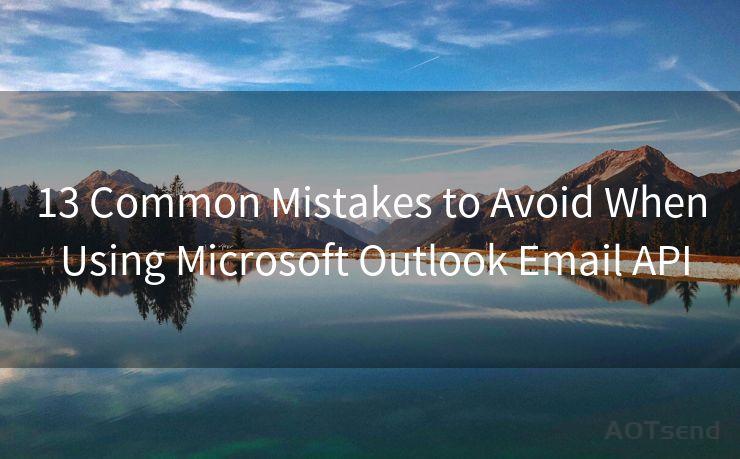13 Common Mistakes to Avoid When Using Microsoft Outlook Email API




Microsoft Outlook Email API is a powerful tool that allows developers to integrate email functionalities into their applications. However, like any complex system, there are common pitfalls that users often fall into. In this article, we'll explore 13 mistakes to avoid when utilizing the Outlook Email API to ensure a smooth and efficient experience.
1. Not Understanding the API Limits
Before diving into the API, it's crucial to understand its limitations. Microsoft sets specific quotas and throttling policies to prevent overuse. Ignoring these limits can lead to blocked requests and potential account suspensions.
2. Improper Authentication
The Outlook Email API requires proper authentication for secure access. Failing to authenticate correctly can result in access denials or security breaches. Always use the recommended OAuth 2.0 authentication flow.
3. Ignoring Error Handling
When working with the API, expect errors. Not implementing robust error handling can lead to unexpected failures and crashes. Make sure to catch and handle exceptions gracefully.
4. Not Utilizing Pagination
When fetching large amounts of data, such as email messages, not using pagination can cause performance issues. The API supports pagination, allowing you to retrieve data in smaller, more manageable chunks.
5. Mishandling of Sensitive Data
Emails often contain sensitive information. Failing to handle this data securely can lead to privacy breaches. Ensure you comply with data protection regulations and encrypt sensitive data.
6. Ignoring Rate Limits
Similar to API limits, rate limits prevent excessive API requests. Ignoring these can cause your application to be throttled or blocked. Monitor your request rates and adjust accordingly.
7. Poorly Structured Queries
When querying the API, poorly constructed requests can lead to inefficient data retrieval or even errors. Optimize your queries for performance and accuracy.
8. Not Testing in a Sandbox Environment
Before deploying to production, it's essential to test your integration in a safe environment. Microsoft provides sandbox environments for this purpose. Skipping this step can lead to unexpected issues in live environments.
9. Failing to Monitor and Log
Proper monitoring and logging are crucial for identifying and troubleshooting issues. Without them, diagnosing problems can be challenging and time-consuming.
10. Assuming the API is Stateless
The Outlook Email API maintains state in certain scenarios, such as when working with attachments or drafts. Assuming it's completely stateless can lead to unexpected behavior.

11. Not Keeping Up with API Updates
Microsoft continuously updates its APIs. Not staying up to date with these changes can lead to broken integrations or missed opportunities to utilize new features.
12. Ignoring Best Practices
Microsoft provides best practices and guidelines for using its APIs. Ignoring these can lead to inefficient or unstable integrations.
13. Not Leveraging Community Resources
The Microsoft developer community is a valuable resource for solving problems and learning best practices. Not tapping into this resource can hinder your progress and learning curve.
By avoiding these 13 common mistakes, you can ensure a smoother, more efficient experience when using the Microsoft Outlook Email API. Remember, the key to success lies in understanding the API's limitations, authenticating properly, handling errors, utilizing pagination, securing sensitive data, respecting rate limits, structuring queries efficiently, testing in a sandbox, monitoring and logging, understanding API state, keeping up with updates, following best practices, and leveraging community resources.
🔔🔔🔔
【AOTsend Email API】:AOTsend is a Managed Email Service for sending transactional emails. Support Email Types: reminders, authentication, confirmations, notifications, verification codes, invoices, password resets, account activations, billing statements, two-factor authentication (2FA), and one-time passwords (OTP) emails, etc. $0.28 per 1000 Emails. 99% Delivery, 98% Inbox Rate.
You might be interested in:
Why did we start the AOTsend project, Brand Story?
What is a Managed Email API, How it Works?
Best 25+ Email Marketing Platforms (Authority,Keywords&Traffic Comparison)
Best 24+ Email Marketing Service (Price, Pros&Cons Comparison)
Email APIs vs SMTP: How they Works, Any Difference?




Scan the QR code to access on your mobile device.
Copyright notice: This article is published by AotSend. Reproduction requires attribution.
Article Link:https://www.mailwot.com/p2630.html



